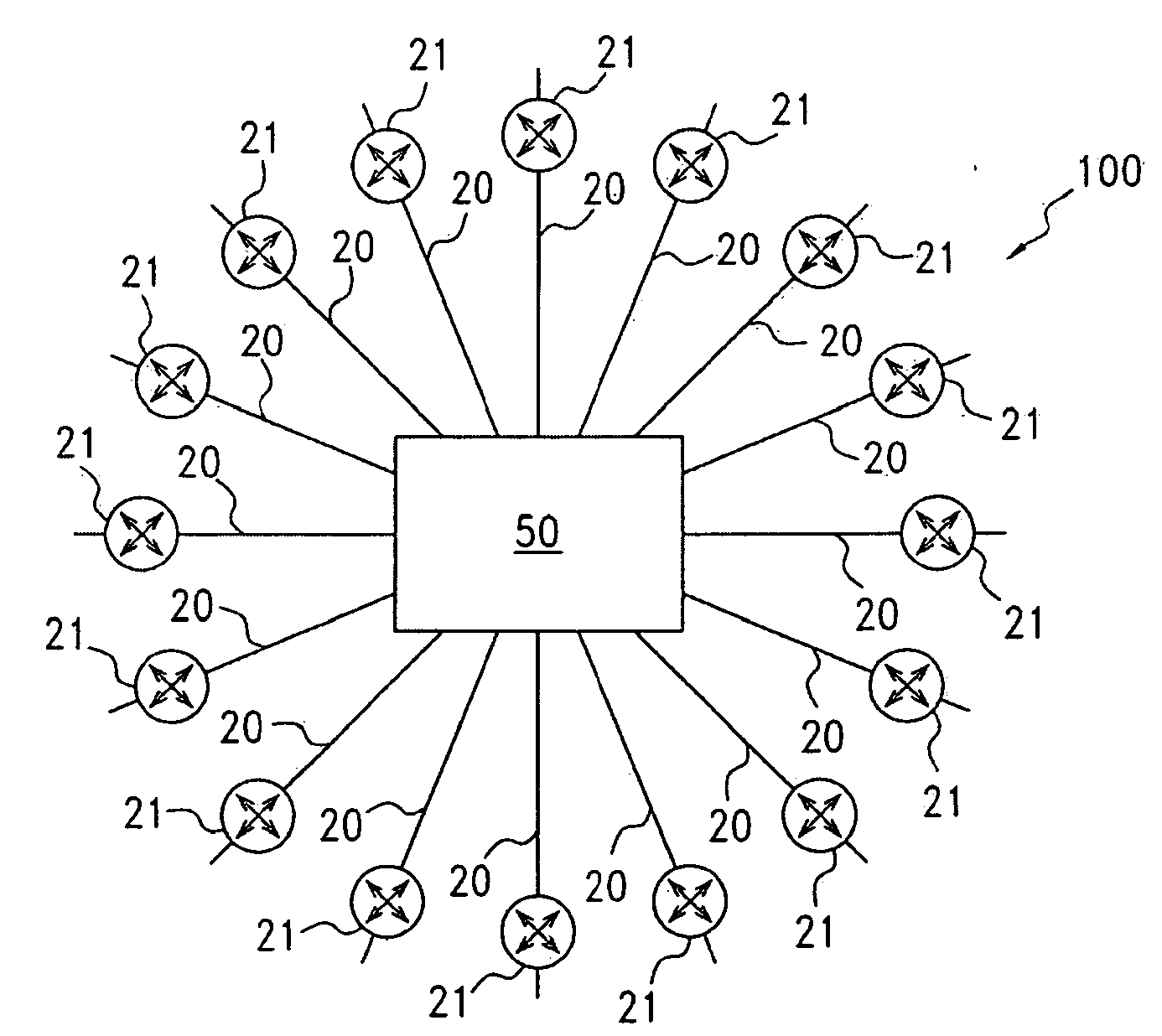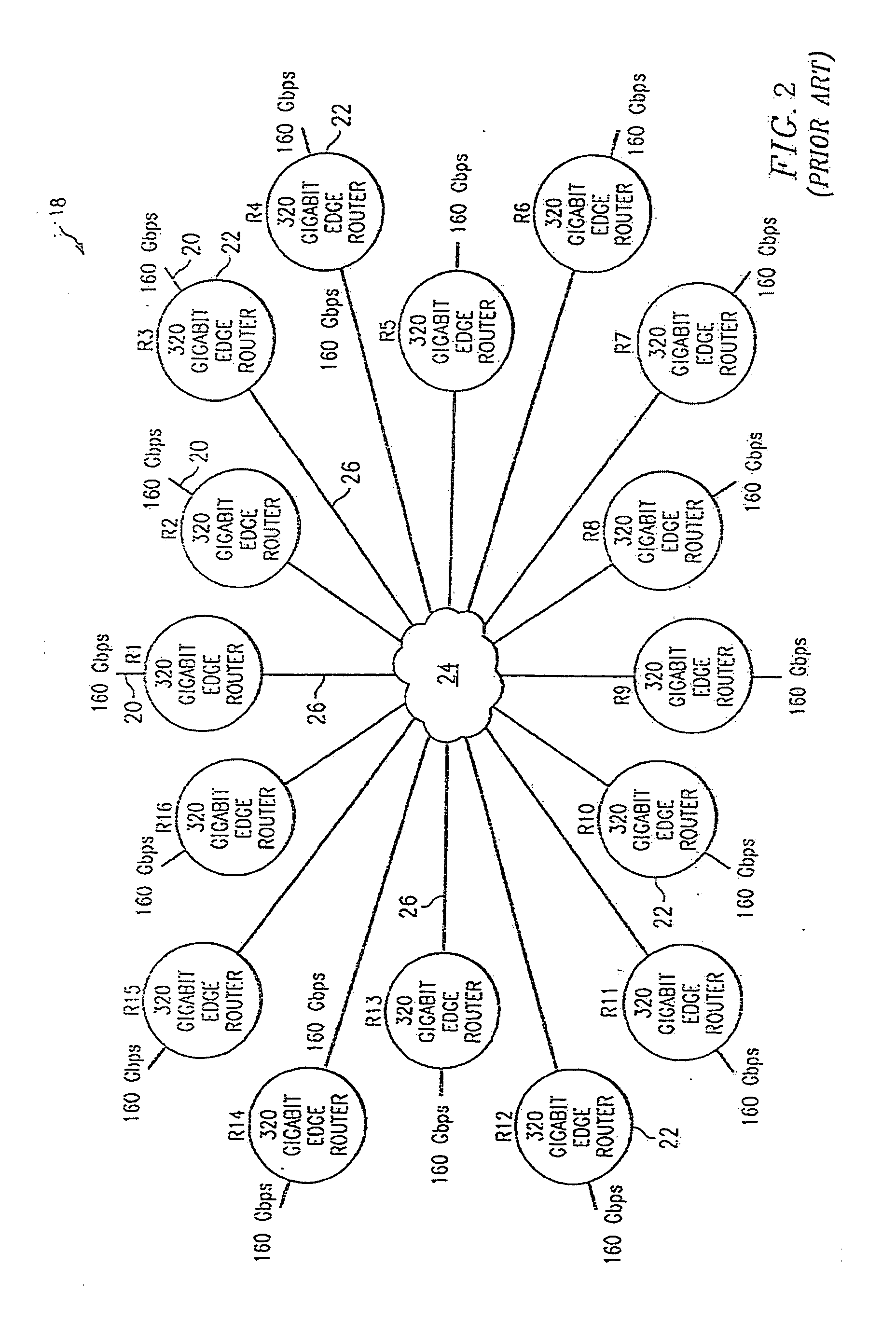[0125]As shown in FIG. 18, the scheduling pattern 84 for ingress edge unit #1 shows the outputting of μλs from ingress edge unit #1 onto ingress μλ link 321 in the following order: one μλ821, one μλ822, one μλ823, two μλs 824, one μλ822, one μλ823, one μλ822, one μλ823 and finally one μλ822 (where the subscript indicates the destination edge unit). The scheduling pattern 86 for ingress edge unit #2 is as follows: one μλ824, one μλ821, one μλ822, one μλ823, one μλ821, two μλs 824, one μλ823, one μλ824 and finally one μλ823. The scheduling pattern 88 for ingress edge unit #3 and the scheduling pattern 90 for ingress edge unit #4 are as indicated in FIG. 18. It can easily be seen that for any selected time, these four scheduling pattern result in four μλs that are destined for a different egress edge unit 60. Thus, the four scheduling patterns 84, 86, 88 and 90 will cause μλs to be sent from the four ingress edge units in a manner that will avoid having two μλs destined for the same egress edge unit arriving at the optical cross bar switch 70 at the same time. Furthermore, the core controller 40 can utilize this algorithm to establish one hundred percent utilization (no data gaps between the optical cross bar switch 70 and the egress edge units on any egress μλ link 32). Thus, FIG. 18 illustrates another technical advantage of the present invention in that the present invention can run in a congested mode (i.e., full utilization) at all times with no packet collision or loss of data. This full utilization maximizes the throughput of data over the available capacity.
[0126]Thus far, the present invention has been described as routing μλs from an ingress edge unit (and ingress port therein unit) to an egress edge unit (and egress port therein), embodiments of the present invention are configurable to employ slot deflection routing in which “orphan” data packets are routed in μλ form through an intermediate edge unit. The slot deflection routing capability can be utilized can be utilized in those cases where no JIT schedule is desired or justified to handle the orphan packages.
[0127]The router 50 of the present invention can use slot deflection routing to route μλ an ingress edge unit to a destination egress edge units through an intermediate edge unit(s) to increase performance of the router 50. FIG. 19 shows an embodiment of the router 50 that utilizes slot routing as opposed to slot deflection routing as opposed to slot deflection routing. FIG. 19 shows multiple edge units 360 connected to one another through the optical switch core 30. Edge units 360 comprise both an ingress edge unit 60 and an egress edge unit 60 so that the functionality of the ingress edge unit 60 and egress edge unit 60 are combined within edge unit 360. Each edge unit 360 has a bi-directional path (input and output) through optical core 30. With reference to FIG. 19, the output path from the ingress function within the edge unit 360 is an ingress μλ link 32, while the input to the egress function within the edge unit 360 is via an egress μλ link 33. Each edge unit 360 also has connectivity between the ingress edge unit 60 and the ingress edge unit 160 within edge unit 360 to allow for exchanging a μλ from an egress edge unit 60 to an egress edge unit 60 for re-transmission to another edge unit 360.
[0128]The following example is used to illustrate both slot routing and slot deflection routing. With reference to FIG. 19, in ordinary slot routing, a μλ from edge unit number 4 that is intended for edge unit number 2 would be routed from edge unit number 4 via ingress μλ link 32 to optical switch core 30. At the optical switch core, the μλ would be switched onto the egress μλ link 32 connected to edge unit number 2 and forwarded to edge unit number 2 for further processing.
[0129]In contrast to slot routing, deflection slot routing involves routing a μλ that is intended for a destination edge unit 360 from the source edge unit 360 through another intermediate edge unit 360, and from the intermediate edge unit 360 to the destination edge unit 360. While the present invention can utilize either slot routing or deflection slot routing, slot routing may not always be the most efficient method. For example, the router may not be load balanced if a particular μλ link needs to transport an amount of data in excess of the μλ link's capacity. Also, a particular link may not be carrying data or may be required to carry some nominal amount of data according to a particular scheduling pattern (the link is “underutilized”). In yet another example, a particular link may simply fail so that no traffic may be carried over that link. One solution to these and other problems is to use deflection routing. With slot deflection routing, if a link between two edge units 360 fails, a μλ to be sent between the edge units can be sent through a different edge unit 40.
[0130]With reference to FIG. 19 for the previous example, presume that for some reason, the most efficient manner to get the μλ from edge unit No. 4 to edge unit No. 2 is to first route (i.e., deflect) the μλ to edge unit No. 0 and then from edge unit No. 0 to edge unit No. 2. In one embodiment, the edge unit No 4 would process the μλ from its ingress edge unit 60 over ingress μλ link 32 to the optical switch core 30 just as in the ordinary slot routing. However, in contrast to ordinary slot routing, the optical switch core 30 will now route the μλ to edge unit No. 0 over egress μλ link 32 to egress edge unit edge unit No. 0. The edge unit No. 0 will then route the μλ internally from its egress edge unit 60 to its ingress edge unit 60. This allows the μλ to be transmitted from an input or receiving module in the edge unit 360 to an output capable or sending module in the edge unit 360. Egress edge unit 60 of edge unit No. 0 can now route the μλ to edge unit No. 2 in the ordinary manner described previously. It should be understood that while a particular embodiment of deflection routing has been described, that other mechanisms of routing to an intermediate edge unit 360 can easily be incorporated to accomplish this deflection routing.
 Login to View More
Login to View More  Login to View More
Login to View More 


